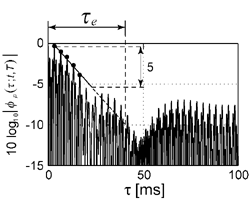A domonstration of the marriage of musical performance and a given sound field by misicians' interpretation styles
Kosuke Kato
Kumamoto University
Kenji Fujii
Yoshimasa Electrics Inc.
Introduction
Each hall has different acoustic environment. Regarding the interaction between the sound source and sound field, we can choose the musical program which is suitable to a given space. For example, chamber music is performed in a small concert hall with short reverberation time. Music tempo and melody are slow enough for a pipe organ in a large cathedral with a long reverberation time.
According to the subjective preference theory [1], the most preferred conditions of the temporal factors, that is, the initial time delay (ITDG) and the reverberation time (RT) are determined by the minimum value of the effective duration of the running autocorrelation function (ACF) of sound signals, (te)min. te is the effective duration of the envelope of the normalized autocorrelation function (ACF), which is defined by the ten-percentile delay, representing a kind of repetitive feature of reverberation contained within the source signal itself.

Figure 1. Example of determining the effective duration (te) of running autocorrelation function.
* Normally, the envelope decay of the initial part of the logarithm of the absolute value of the r-ACF is linear. As a simple calculation, major local peaks corresponding to a multiple of fundamental period, in the range of first major peak to first major peak minus 5 (in dB scale), are fitted by a straight line using least mean square method. If all major local peaks from the origin to t = 50 ms exceed the first major peak's amplitude, minus 5, then all major local peaks are fitted. The effective duration (te) is obtained from the decay rate extrapolated to -10.
1. The music program can be chosen according to the sound field of a given hall.
Generally, the te of the music pieces with fast tempo is long, and the te of slow tempo music is short. For the (large) hall which has longer ITDG and RT a fast tempo music can be chosen while a slow tempo music can be chosen for the (small) hall which has shorter ITDG and RT.
2. Performer can control thier musical performance according to the sound field of a given hall.
There are several previous studies. The te of the piano performance can be controlled by the speed of performance or tempo, dynamics, articulation, synchronization, pedaling, and note-off tail [2]. The te of the vocal sound can be controlled by the singing style (for example, [3]).
If musician can check the te of their performance in real time, and find the difference of te according to the different performance style, musician may control their performance to approach the preferred condition of the sound field. During the demonstration, how the te of the vocal sound changed by the different singing style was demonstrated.
Two Matlab programs are provided:
realtime_taue_analysis_main.m
The realtime behaviour of the waveform, amplitude in dB, autocorrelation function and te for any input signal can be indicated.
realtime_vibrato_analysis_main.m
The realtime behaviour of the waveform, amplitude in dB, autocorrelation function and fundamental frequency for any input signal can be indicated.
(Other related files and a sample music signal are provided toghther in a file compressed.)
Download compressed Matlab files (LZH format): 614 KB
Refernces
[1] Y. Ando. (1998). Architectural Acoustics: Blending Sound Sources, Sound Fields, and Listeners. AIP Press/Springer Verlag, New York.
[2] T. Taguti and Y. Ando. (1997). Caracteristics of the short-term autocorrelation function of sound signals in piano performances. Music and Concert Hall Acoustics, Conference proceedings of MCHA 1995 (Eds. Y. Ando and D. Noson). Academic Press, London, Chap. 23.
[3] K. Kato and Y. Ando. (2002). A studyof the blending of vocalmusicwith the sound field by different singing styles. Journal of Sound and vibration, 258, 463-472.